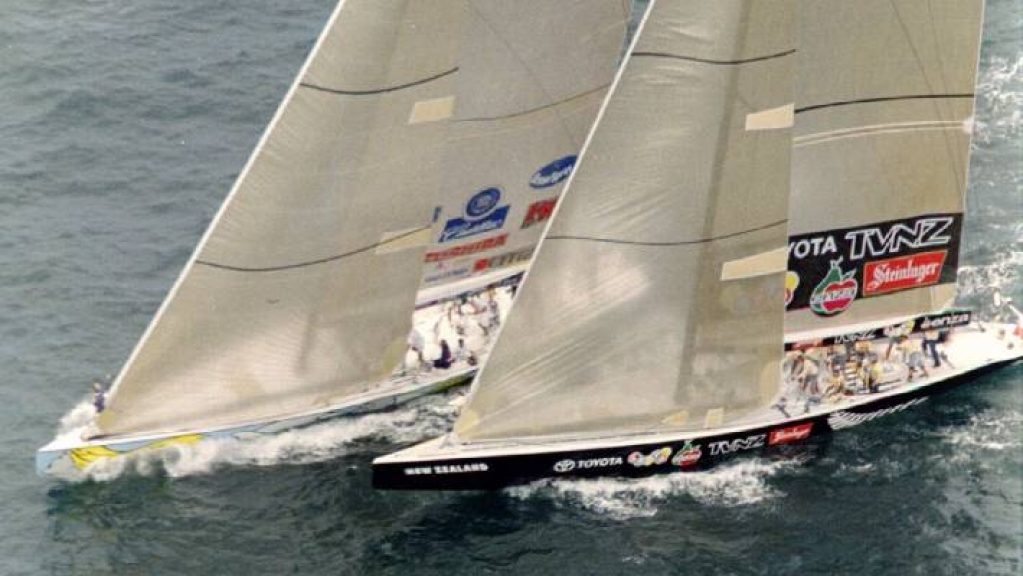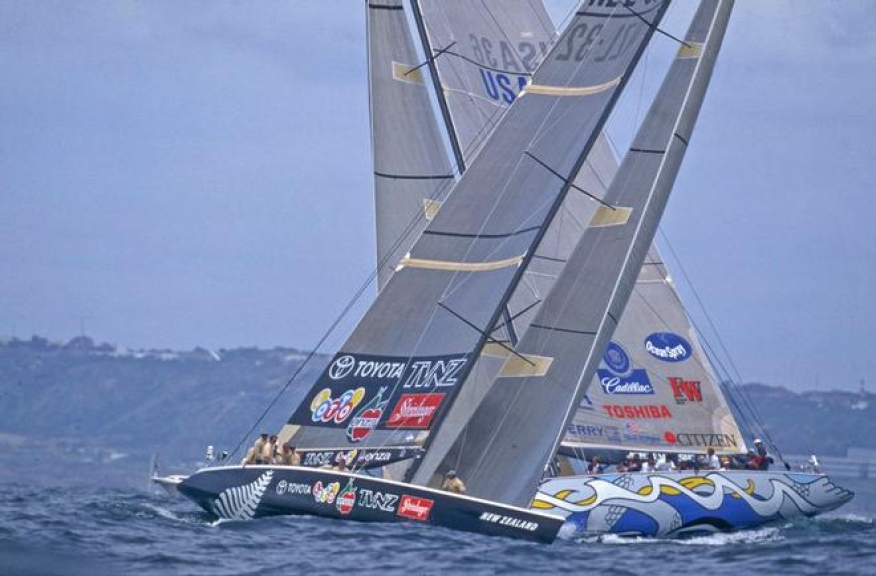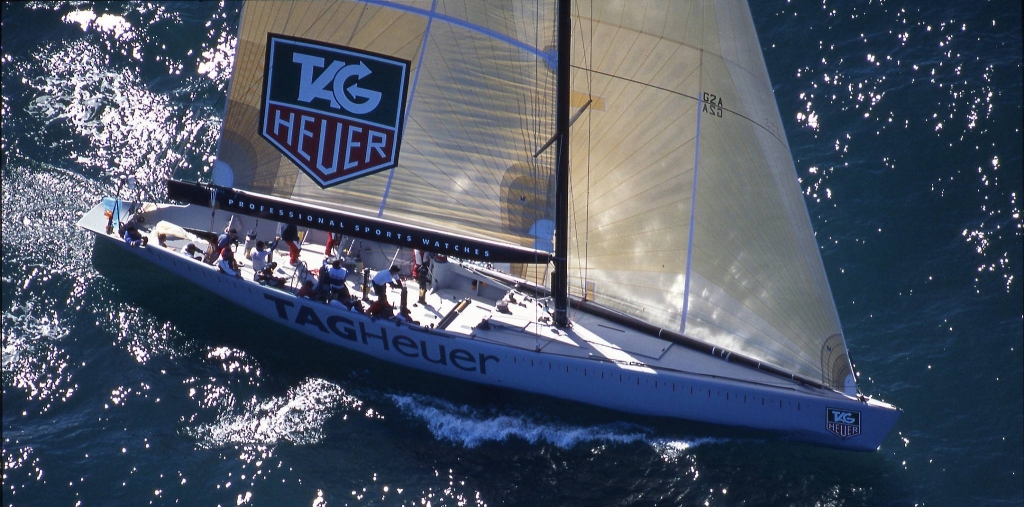By Dr Hamish Ross
As unbelievable as it may seem to those who took part or witnessed it, 13 May 2020 (14 May 2020 - New Zealand Time) will mark a quarter of a century since Team New Zealand in Black Magic (NZL 32) completed one of the most comprehensive victories in the history of the America’s Cup, winning all five races of the 1995 Cup match with margins as much as 4:14. It is one of those days were you remember where you were for New Zealanders above a certain age. The opponent was the colourful Roy Lichtenstein painted Young America (USA 36) (aka the “Mermaid” or “Dorothy”- after surviving damage in a tornado), skippered by New Zealand’s greatest yachting nemesis – Dennis Conner, who called tactics for his helmsman, New Zealand’s 1992 nemesis, Paul Cayard. Conner before the match had swapped out the slower Stars and Stripes (USA 34) for Young America in a vain search for boat speed.

Black Magic (NZL 32) and Young America (USA 36) battle for position in the pre-start of the 1995 America's Cup
For New Zealand, it was an exorcism of America’s Cup ghosts past. After over eight years and hard-fought campaigns, where the hopes of the nation had been ripped open, often after promising starts. First; by Dennis in Stars and Stripes in the 1987 Louis Vuitton Cup Final off Fremantle, Australia (“So if you wanted to build a glass boat, then why would you do it? Unless you wanted to cheat!”); by Dennis once again in 1988 in a controversial Stars and Stripes, but this time a catamaran in 1988 off San Diego, where the final result would see-saw in the New York courts for two more years (“I’m sailing a cat … someone else is sailing a dog”); and in 1992 when high hopes would be dashed by Paul Cayard helming for the Italians on II Moro di Venezia by a destabilising protest during the Louis Vuitton Cup final (Raul Gardini, leader of the Italian challenger, accused the New Zealanders of sailing (“with an unsportsmanlike manner”). "Revenge is a dish that tastes best when it is cold," so said Don Corleone in The Godfather. With both Dennis and Paul on Young America, it was 3-star Michelin dining.

Black Magic (NZL 32) and Young America (USA 36) cross during the 1995 America's Cup
The Team learnt not only from these hard experiences, but some of the Team had also sailed with Dennis in other events, such as the 1993-94 Whitbread Around the World Race. Brad Butterworth says “It gave us an opportunity for a unique insight into what was required to win and defend the America’s Cup, something we could have never obtained otherwise.”
Team New Zealand’s win was the greatest sporting moment in New Zealand’s long history of sporting success. Team New Zealand’s campaign was led by the late Sir Peter Blake (as he would soon become), who sailed as one of the crew on Black Magic and who after the win, stood atop New Zealand’s sporting pantheon along with Sir Edmund Hillary, Sir Peter Snell and Sir Colin Meads amongst other icons of New Zealand sport. The Team deliberately broke the mould of past New Zealand Cup challenges with a much-renewed emphasis and focus on teamwork, team culture, team leadership and team participation. The Team was led from the yacht, rather from the designers or management ashore. Even a management textbook would be published on Team New Zealand’s team management principles.

Black Magic (NZL 32) preparing to go around the top mark in the 1995 America's Cup
An entirely new design team was assembled, and it learnt much from the scientific approach of Bill Koch’s successful America3 campaign of 1992, hiring several key design personnel from that team. A breakthrough yacht was built by McMullin and Wing in Black Magic NZL32, but amazingly, its outstanding performance, apparent from its first sail, was kept under wraps as rumours were successfully spread by the Team that Black Magic NZL 32 was a failure. The international America’s Cup media continued to write off the New Zealand challenge up until after the first races of the Louis Vuitton Cup round robins. Even then, Team New Zealand sailed NZL 38 up to the LVC semi-finals, keeping the Black Magic NZL-32 secret as late as possible. Back home, New Zealand needlessly fretted that another challenge was about to hit the rocks following the exchange from NZL-38 that literally, in one instance, had left a competitor sunk. It was the first time a New Zealand team won the Louis Vuitton Cup, a feat since repeated three further times since in 2007, 2013, and 2017. Nice, but the Team had come for the big prize.
It should not be forgotten that New Zealand had another challenger in the Louis Vuitton Cup semi-finals, Tag Heuer (NZL 39) representing the Tutukaka South Pacific Yacht Club, helmed by Chris Dickson, and it narrowly missed out on making an all New Zealand Louis Vuitton Cup final.

Tag Heuer (NZL 39), helmed by Chris Dickson, narrowly missed making the Louis Vuitton Cup final an all New Zealand affair.
In New Zealand, on Sunday, 14th May 1995, some 92% of the New Zealand nation of 3.5m people, anxiously watched or listened to the final race of the match. TV coverage lasted for a record 13 hours that day. No New Zealander dared to believe in victory before the finish, which would see the coveted America’s Cup being brought to New Zealand for the first time. Most were wearing that day their lucky red socks purchased after Blake put a rare loss down to the absence of his lucky red socks. 100,000 red socks were immediately made and snapped up by the New Zealand public in support. People were scolded for not wearing them, least bad luck be again visited on Team New Zealand. European, Maori, Pacifica and Asian alike, watched and listened as one people from Antarctica to North Cape, in homes to cowsheds, clubs to pubs, as Peter J Montgomery called the race. PJ had single-handed over the years created a nation of sailing experts, all now capable of expertly assessing the efficiency of gybes, slam-dunks, mark-roundings, as well as the design merits of each yacht. All had suffered from the Cup disappointments of the past and none quite believed, what was happening across the Pacific dateline, far to the east in San Diego.
The mustard-yellow shirted heroes aboard Black Magic did not disappoint, although there were a few anxious moments for fans when Young America took the first shift off the start line to take the lead, threatening to spoil the party and both yachts later suffered from jib halyard failures. “The America’s Cup is now New Zealand’s Cup” immortally declared PJ. “Slaughter on the Water”. One international sailing writer labelled it. “A little bit of boat speed can make you famous,” later claimed Skipper Russell Coutts. A champagne soaked Sir Peter Blake declared at the post-race press conference he was; “Not really fit to tell you anything right now … which I hope is understandable”, charming the international media pack sharing the historic America’s Cup moment. Dennis Conner was very gracious after his second America’s Cup loss, declaring New Zealand will be a great home for the America Cup.

Champagne celebrations after winning the 1995 America's Cup
The celebrations in New Zealand after the win were likened to those of 1945 on VE and VJ day. Parades with hundreds of thousands of spectators were held to welcome Team New Zealand and the Cup in all the major centres, which have never been matched since. Sailing had briefly eclipsed the established sporting religion of rugby. The America’s Cup victory in 1995, brought a nation together like no other event. Like flies to carrion, politicians and dignitaries could not get enough pictures of themselves with the Team and the Cup, as it swept across down the country and as Team New Zealand took all the major sporting awards that year. Royal honours were showered on key team members and a special medal struck and presented to all the members of Team New Zealand to mark the importance of the achievement and the win for all New Zealand.

An estimated 250,000 people greet the team at the 1995 victory Parade in Auckland
The 1995 victory left any important and lasting legacies, the most important was that it demonstrated to us, what a small isolated nation, situated “at the last bus stop before the penguins”, can achieve in any field of endeavour on the world stage. Doing so on a very modest, but wisely spent budget of NZD$27m and were busy fundraising right up to the last race. By comparison, Bill Koch had spent US$68m in his successful 1992 America3 defence. The win would transform the City of Auckland, refocusing it towards the stunning Waitemata Harbour, a process that continues apace today. The 1995 Cup win continues to inspire young sports men and women to achieve beyond what they thought capable. Today’s Skipper of Emirates Team New Zealand, Peter Burling, was a 4-year old boy when the Cup was first lifted by Kiwi hands, unaware that his date with Cup destiny would arrive 22 years later. Somewhere out there is another young New Zealand destined to be another Russell or Peter for New Zealand.
Before being retired, Black Magic served as a trial yacht for Team New Zealand’s 2000 defence of the Cup, a trial and training yacht for the 2003 French America’s Cup team Le Defi and later for the China Team. Today Black Magic lies restored to her 1995 glory on display as an important cultural artefact inside the New Zealand National Maritime Museum on Auckland’s waterfront, surrounded by memorabilia of Sir Peter Blake’s all too short, but highly productive life. Meanwhile, Young America, designed by PACT was donated in 2003 to the Storm King Art Center in Mountainville, New York State, as a work of art for public display. In 2017, Young America was moved to Middlebury College, Vermont for an exhibition.
The Cup would remain in New Zealand for eight years, where it was successfully defended in 2000 in a similar dominating victory, going one better than our sporting rivals across the Tasman, who had failed to defend the Cup during their first defence in 1987. The Cup would be lost in a heartbreaking defence of 2003. Emirates Team New Zealand soon recovered, to sail in stormy Cup seas and in 2017 it would repeat the feat of 1995. The Team is now focused in trying pandemic times, to also repeat the successful 2000 defence.
Aboard Black Magic (NZL 32) of that famous day in May were:
Skipper/Helm: Russell Coutts
Tactician: Brad Butterworth
Navigator: Tom Schnackenberg
Afterguard: Murray Jones, Rick Dodson
Foredeck: Dean Phipps; Joe Allen; Matthew Mason; Jeremy Scantlebury; Ross Halcrow
Grinders: Craig Monk; Andrew Taylor
Sail Trimmers: Simon Daubney; Robbie Naismith; Warwick Fleury; Peter Blake
Many would go on to more America’s Cup glory. A record eight of them have to date, been elected to the America’s Cup Hall of Fame based in Bristol, Rhode Island. The most successful since is perhaps Murray Jones (aka “the Captain”) who can now claim a record six America’s Cup wins as a Cup team member between 1995-2017.
The crew’s efforts were only made possible by a strong and focused design team, support team and management team, as well as the support of its many sponsors, not only the corporates which featured on the yacht, but from every New Zealander.
The 1995 Black Magic Record
Louis Vuitton Cup
14 January – 21 April 1995
Round Robin 1: 6 wins no losses; NZL-38
Round Robin 2: 5 wins one loss; NZL-38
Round Robin 3: six wins no losses; NZL-38
Round Robin 4: five wins one no result (due to the sinking of OneAustralia); NZL-38
Semi-finals: 9 wins two DNS; NZL 32
Finals: 5 wins one loss; NZL-32
America’s Cup
May 6-13 1995
Race 1: Black Magic (NZL-32) def Young America (USA-36) by 2:45
Race 2: Black Magic (NZL-32) def Young America (USA-36) by 4:14
Race 3: Black Magic (NZL-32) def Young America (USA-36) by 1:51
Race 4: Black Magic (NZL-32) def Young America (USA-36) by 3:37
Race 5: Black Magic (NZL-32) def Young America (USA-36) by 1:50